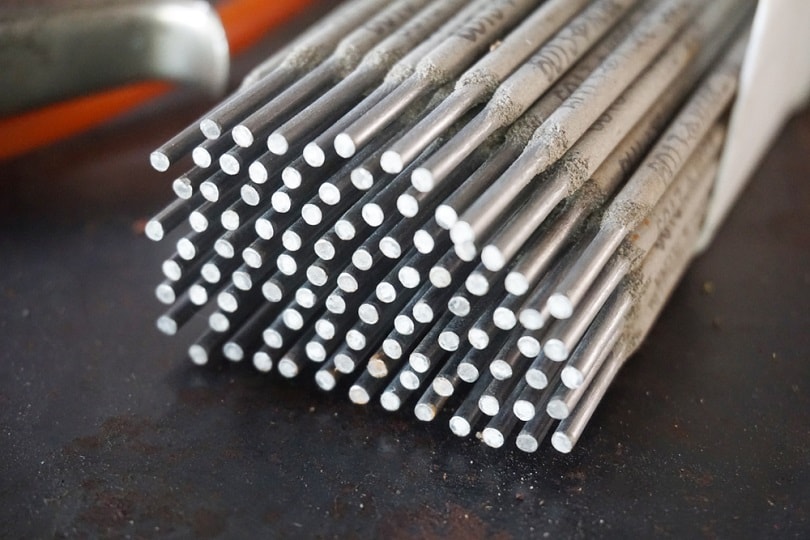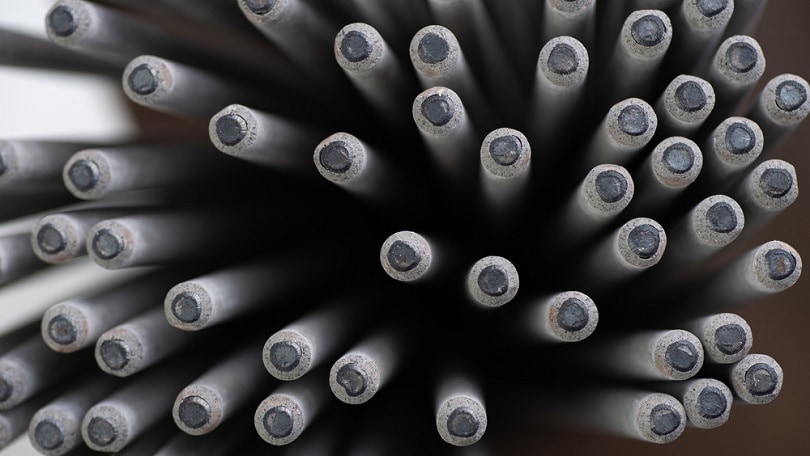Electrode Welding: What is it & How To Choose? (with Chart)
Last Updated on

Commonly known as Shielded Metal Arc Welding (SMAW) or Arc welding by some old-timers in the field, Electrode welding is one of the oldest welding processes still used in construction and fabrication today. It’s used in pipe welding, ironworking, and some fabrication. While in a fabrication setting it has largely been supplanted by Flux-Cored Arc Welding, Electrode welding is still highly valuable due to its simple equipment setup. Additionally, it is usually the first process taught to welding students since it most clearly demonstrates the fundamental principles of welding.
Electrode Welding: How it Works
The Electrode welding setup consists of a welding machine, electrode holder (stinger), and a ground clamp. The stinger and the ground clamp lead, which will be attached to the workpiece, are plugged into both terminals of the power source. The terminals are positive and negative of the current flow. Different types of electrodes will require different polarities. This means that if the designated polarity is DCEP (Direct Current Electrode Positive), the stinger lead would be plugged into the positive terminal.
Electrode welding works off of this constant current (CC) by short-circuiting between a flux-covered electrode held in the stinger and the workpiece. This creates an electrical arc that generates heat to melt the workpiece and the electrode simultaneously. The electrode melts to deposit filler metal into the weld pool (the puddle of molten metal created by the heat of the arc). At the same time, the flux on the outside of the electrode rod burns and creates a protective slag for the weld which can then be chipped off afterward. There are a variety of fluxes depending on the type of weld, material, and application. See the figure below.
The voltage (electrical pressure) will change depending on the arc length which is manually changed as the electrode is drawn away and pushed closer to the workpiece. The further away the electrode is, the more voltage in the current and vice versa.
- Relatively simple equipment setup
- Can weld outside in the wind
- Extended electrode length allows for welding in hard-to-reach places
- Deposition rate is one of the lowest among welding processes
- Requires a steady hand
- Weld appearance not typically aesthetically pleasing

Understanding Electrode Coating
Consumable electrodes have a coating. There are non-consumable electrodes as are used in TIG welding (Tungsten Inert Gas), very often made of tungsten. These do not require coating since the weld is protected by shielding gas. Properly speaking, the electrode is the non-workpiece side of the current that initiates the short-circuiting for the electrical arc. Electrode welding, or Stick welding, uses electrode rods covered in a flux, each of which has various properties and uses.
The electrode coating can help stabilize the arc, create smooth weld appearance, and increase the deposition rate among other things. For example, E7018, one of the most common welding electrodes for welding per structural steel building code, has a coating described as iron powder low hydrogen. This coating in particular helps extra metal to be deposited into the weld pool. See the chart below that details some of the weld characteristics for each coating.
- See also: How to Build Welding Lead Reels
Electrode Coating Chart
Code
Electrode type
Properties and use
A
Acidic coating
High arc stability, very fluid weld pool, rarely used
C
Cellulose coating
Intensive arc, little slag, high fusion rate in the area of the weld pool, hard to weld
R
Rutile coating
Spray transfer, easy to weld, flat seams, poor gap-bridging ability
RR
Thick rutile coating
Spray transfer, easy to weld, flat seams, poor gap-bridging ability
RC
Rutile cellulose coating
Spray transfer, easy to weld, flat seams, poor gap-bridging ability
RA
Rutile acidic coating
Spray transfer, easy to weld, flat seams, poor gap-bridging ability
RB
Rutile basic coating
Spray transfer, easy to weld, flat seams, poor gap-bridging ability
B
Basic coating
Suitable for high-strength connections, welding ability in various positions, slightly harder to weld than rutile coated electrodes
Source: https://www.fronius.com/en/welding-technology/world-of-welding/electrode-welding
FAQs of Electrode Welding
What are the three types of welding electrodes?
As far as electrode coating, the three types are cellulose, rutile, and basic. However, there are more than three different types of electrodes. They are not all interchangeable. E6010, for example, is used for the root pass in pipe applications. But E7018 can be used for the fill and cap of the joint. They all require specific training and practice to function properly.
What is a welding electrode made of?
At the core of the welding rod is the metal to be deposited into the weld joint. This may be cast iron, mild steel, aluminum, stainless steel, or another alloy.
What is the strongest welding rod?
This is debatable and opinions will vary. However, E7018 can produce welds that have a tensile strength of 70,000 PSI (pounds per square inch). This is probably the most widely-used welding rod for welding per structural code.
Final Thoughts: Electrode Welding
Your grandfather’s old arc welder sitting in the garage is probably as useful as ever. There are some ways of welding that just cannot be replaced. The versatility and portability of this process are unmatched. While automated and semi-automatic welding processes like MIG have the edge as far as speed and deposition rate, electrode welding will always be the favorite and most fundamental process to learn.
Featured image credit: Pongsak14, Shutterstock
